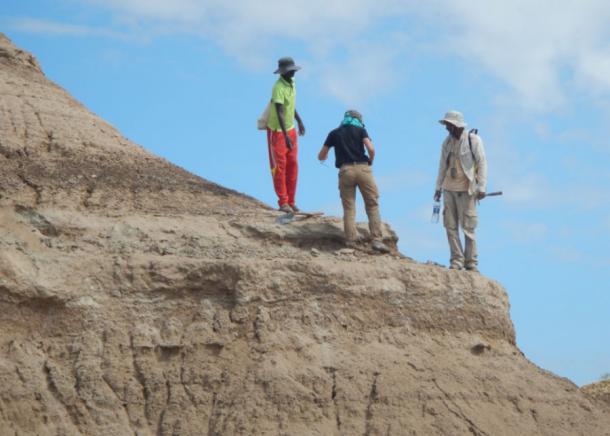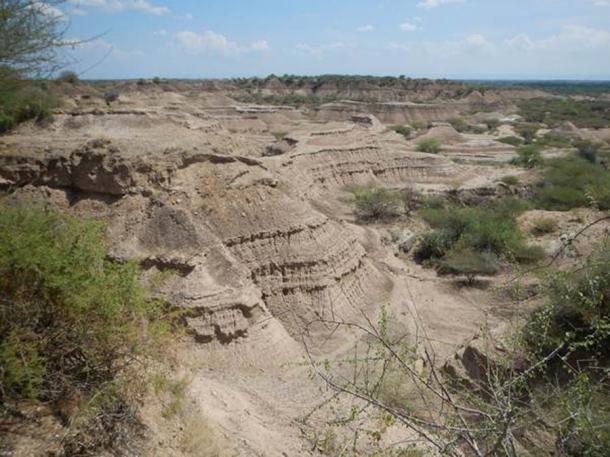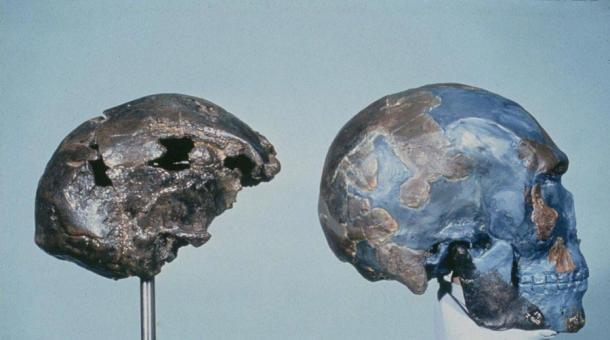The debate around human evolution and the Out-of-Africa theory has received a fresh update, this time from southwestern Ethiopia’s Omo Kibish region. A study in Nature has pointed out how the Homo sapiens fossils found in this region in 1967, are at least 36,000 years older than previously estimated, much more in line with recent fossil discoveries from Jebel Irhoud in Morocco that pegged the earliest Homo sapiens evolution to around 300,000 years ago!

Reproduction of the skull of Omo I found at the Omo Kibish site in Ethiopia, on display at the Musée des Civilisations Noires de Dakar, Sénégal. ( CC BY-SA 4.0 )
Omo Kibish Fossils Older Based on Volcanic Ash Evidence
The recent study by researchers from the University of Cambridge, UK, dates the 1967 Omo I fossils found at the Omo Kibish site in Ethiopia to 233,000 (±22,000) years ago. The team, led by volcanologist Dr. Celine M. Vidal, analyzed the geochemical fingerprints of a thick layer of volcanic ash, from a vast eruption that occurred roughly 233,000 years ago, found above the sediment layer where the Omo remains were discovered.
“Using these methods, the generally accepted age of the Omo fossils is under 200,000 years, but there’s been a lot of uncertainty around this date. The fossils were found in a sequence, below a thick layer of volcanic ash that nobody had managed to date because the ash is too fine-grained,” said Dr. Vidal.

The research study team sampling ash deposits that have helped to more accurately date the oldest Homo sapiens fossils found at the Omo Kibish site. (Alan Deino 2018 / Nature)
In the sedimentary layering, the Omo Kibish human fossils were located beneath the ash, indicating that they are older than the eruption. The volcanic remains were dated by collecting pumice rock samples from volcanic deposits and grinding them down to sub-millimeter size, reports The Daily Mail . Omo I refers to the famous group of fossils discovered by Kenyan paleoanthropologist Richard Leakey, one of the children of legendary archaeological duo Mary and Louis Leakey .

The Omo Kibish formation in Ethiopia where Richard Leakey found the Omo I human remains in the late 1960s. (Céline Vidal 2018 / Nature)
The Scientific Methods Used to Date the Omo I Remains
Dr. Vidal explained, “Each eruption has its own fingerprint – its own evolutionary story below the surface, which is determined by the pathway the magma followed. Once you’ve crushed the rock, you free the minerals within, and then you can date them, and identify the chemical signature of the volcanic glass that holds the minerals together.”
That ash layer displayed a chemical fingerprint matching that of a volcanic crater located 350 kilometers (250 miles) northeast of the Kamoya Hominin Site (KHS) created by the eruption of the ancient Shala volcano. The challenge was that though there was a match, the Shala volcano’s eruption had never been dated. To date the eruption, Dr. Vidal and her team sent ash samples to Glasgow, Scotland, where they were scientifically analyzed using the latest methods.
The researchers were able to determine that the massive Shala eruption spewed volcanic ash, which drifted and settled over the Omo Kibish site. Dating of the hardened ash found in the volcanic crater led to the new age estimate for the human fossils, reports Science News .
Omo I is believed to unequivocally possess the characteristics of modern humans , including a tall and globular cranial vault, “making it the oldest unchallenged H. sapiens in Africa,” according to study co-author Dr. Aurélien Mounier, from the Musée de l’Homme in Paris.
In contrast, he added that the Jebel Irhoud remains found in Morocco “do not possess some of the key morphological features that define our species. They particularly lack a tall and globular cranial vault and a chin on the lower jaw, which can be observed on Omo I.” This is in line with the findings of a large group of scientists who’ve argued that the Moroccan fossils may not even belong to our species.

Replicas of Omo Kibish 2 (left) and Omo Kibish 1 (right). Omo 1 shows much clearer modern Homo sapiens features. ( Chris Stringer )
Moving Forward
Another key takeaway from the latest Nature study is the resilience of early modern humans, who survived extreme climatic instability, particularly in areas prone to large-scale natural disasters. The Rift Valley probably provided considerable water resources though rainfall collection and the formation of small freshwater lakes that attracted hordes of animals. The volcanoes also provided early humans with unique opportunities to make stone tools.
Professor Christine Lane, co-author, and head of the Cambridge Tephra Laboratory concluded, “Our forensic approach provides a new minimum age for Homo sapiens in eastern Africa, but the challenge still remains to provide a cap, a maximum age, for their emergence, which is widely believed to have taken place in this region. It’s possible that new finds and new studies may extend the age of our species even further back in time.”
Top image: The Omo Kibish formation where the fossils of the oldest Homo sapiens were discovered. Inset: Reproduction of an Omo I skull. Source: Céline Vidal 2018/ Nature (Inset: CC BY-SA 4.0 )
By Sahir Pandey
References
Bower, B. 2022. Homo sapiens bones in East Africa are at least 36,000 years older than once thought . Available at: https://www.sciencenews.org/article/homo-sapiens-human-bones-ethiopia-omo-africa-older
Dunham, W. 2022. Older date for Ethiopian fossils sheds light on rise of Homo sapiens . Available at: https://www.reuters.com/lifestyle/science/older-date-ethiopian-fossils-sheds-light-rise-homo-sapiens-2022-01-12/
Morrison, R. 2022. Ancient human remains discovered in Ethiopia are much OLDER than first thought and likely pre-date a massive volcanic eruption over 230,000 years ago, study finds . Available at: https://www.dailymail.co.uk/sciencetech/article-10391337/Ancient-human-remains-discovered-Ethiopia-OLDER-thought.html
Vidal, C. M., Lane, C. S., et al . 2022. Age of the oldest known Homo sapiens from eastern Africa . Nature. Available at: https://doi.org/10.1038/s41586-021-04275-8
 RSS Feed
RSS Feed













 January 14th, 2022
January 14th, 2022  Awake Goy
Awake Goy  Posted in
Posted in  Tags:
Tags: 
















